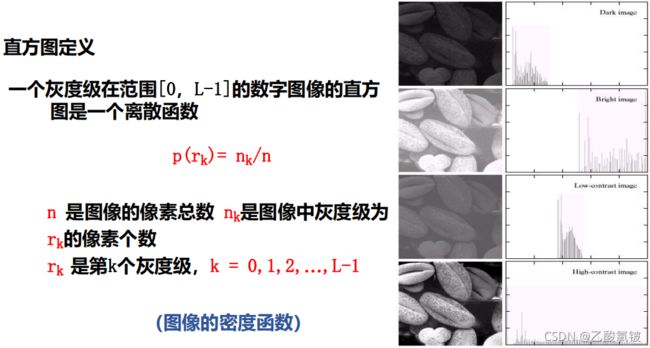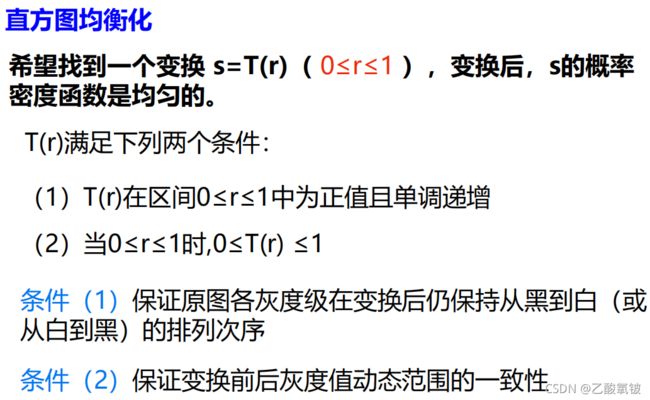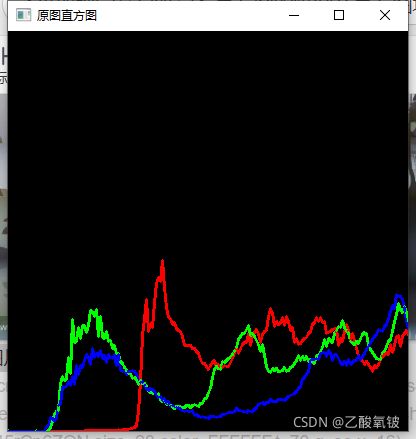【机器视觉学习笔记】直方图的绘制及直方图均衡化(C++)
目录
- 概念
-
- 直方图定义
- 直方图均衡化
-
- 为什么要选用累积分布函数
- 如何运用累积分布函数使得直方图均衡化
- C++ 源码
-
- 直方图均衡化
- 绘制直方图
- 主函数
- 效果
- 完整源码
平台:Windows 10 20H2
Visual Studio 2015
OpenCV 4.5.3
本文综合自直方图计算和程序员-图哥——图像处理之直方图均衡化及C++实现
概念
直方图定义
直方图均衡化
有两个问题比较难懂,一是为什么要选用累积分布函数,二是为什么使用累积分布函数处理后像素值会均匀分布。
为什么要选用累积分布函数
均衡化过程中,必须要保证两个条件:
①像素无论怎么映射,一定要保证原来的大小关系不变,较亮的区域,依旧是较亮的,较暗依旧暗,只是对比度增大,绝对不能明暗颠倒;
②如果是八位图像,那么像素映射函数的值域应在0和255之间的,不能越界。
综合以上两个条件,累积分布函数是个好的选择,因为累积分布函数是单调增函数(控制大小关系),并且值域是0到1(控制越界问题),所以直方图均衡化中使用的是累积分布函数。
如何运用累积分布函数使得直方图均衡化
直方图均衡化过程中,映射方法是

其中,n是图像中像素的总和, n k n_k nk是当前灰度级的像素个数,L是图像中可能的灰度级总数。
C++ 源码
直方图均衡化
直方图均衡化的代码实现有以下几个步骤:
遍历全图,先统计每个灰度级下的像素点个数(为此我们开辟了256大小的数组);
计算每个灰度级的像素点占总像素的点的比例;
按照第二步求出的比例重新计算每个灰度级下的新的灰度值,即均衡化;
依照新的灰度值表遍历更新图像的灰度值。
Mat getEqualizeHistImage(Mat input)
{
int gray[256] = { 0 }; //记录每个灰度级别下的像素个数
double gray_prob[256] = { 0 }; //记录灰度分布密度
double gray_distribution[256] = { 0 }; //记录累计密度
int gray_equal[256] = { 0 }; //均衡化后的灰度值
int gray_sum = 0; //像素总数
Mat chRGB[3];
split(input, chRGB);
Mat output = input.clone();
for (unsigned char k = 0; k < 3; ++k)
{
for (unsigned short i = 0; i < 256; ++i)
{
gray[i] = 0;
gray_prob[i] = 0;
gray_distribution[i] = 0;
gray_equal[i] = 0;
}
gray_sum = chRGB[k].cols * chRGB[k].rows;
//统计每个灰度下的像素个数
for (int i = 0; i < chRGB[k].rows; i++)
{
uchar* p = chRGB[k].ptr<uchar>(i);
for (int j = 0; j < chRGB[k].cols; j++)
{
int vaule = p[j];
gray[vaule]++;
}
}
//统计灰度频率
for (int i = 0; i < 256; i++)
{
gray_prob[i] = ((double)gray[i] / gray_sum);
}
//计算累计密度
gray_distribution[0] = gray_prob[0];
for (int i = 1; i < 256; i++)
{
gray_distribution[i] = gray_distribution[i - 1] + gray_prob[i];
}
//重新计算均衡化后的灰度值,四舍五入。参考公式:(N-1)*T+0.5
for (int i = 0; i < 256; i++)
{
gray_equal[i] = (uchar)(255 * gray_distribution[i] + 0.5);
}
//直方图均衡化,更新原图每个点的像素值
for (int i = 0; i < chRGB[k].rows; i++)
{
uchar* p = chRGB[k].ptr<uchar>(i);
for (int j = 0; j < chRGB[k].cols; j++)
{
p[j] = gray_equal[p[j]];
}
}
}
merge(chRGB, 3, output);
return output;
}
绘制直方图
Mat getHistImage(Mat input)
{
Mat chRGB[3];
split(input, chRGB);
// 设定bin数目
int histSize = 255;
// 设定取值范围 ( R,G,B) )
float range[] = { 0, 255 };
const float* histRange = { range };
bool uniform = true; bool accumulate = false;
Mat RGB_Hist[3];
for(uint8_t i = 0; i < 3; ++i)
// 计算直方图:
calcHist(&chRGB[i], 1, 0, Mat(), RGB_Hist[i], 1, &histSize, &histRange, uniform, accumulate);
// 创建直方图画布
int hist_w = 400; int hist_h = 400;
int bin_w = cvRound((double)hist_w / histSize);
Mat histImage(hist_w, hist_h, CV_8UC3, Scalar(0, 0, 0));
for(uint8_t i = 0; i < 3; ++i)
// 将直方图归一化到范围 [ 0, histImage.rows ]
normalize(RGB_Hist[i], RGB_Hist[i], 0, histImage.rows, NORM_MINMAX, -1, Mat());
// 在直方图画布上画出直方图
for (int i = 1; i < histSize; i++)
{
line(histImage, Point(bin_w*(i - 1), hist_h - cvRound(RGB_Hist[0].at<float>(i - 1))),
Point(bin_w*(i), hist_h - cvRound(RGB_Hist[0].at<float>(i))),
Scalar(0, 0, 255), 2, 8, 0);
line(histImage, Point(bin_w*(i - 1), hist_h - cvRound(RGB_Hist[1].at<float>(i - 1))),
Point(bin_w*(i), hist_h - cvRound(RGB_Hist[1].at<float>(i))),
Scalar(0, 255, 0), 2, 8, 0);
line(histImage, Point(bin_w*(i - 1), hist_h - cvRound(RGB_Hist[2].at<float>(i - 1))),
Point(bin_w*(i), hist_h - cvRound(RGB_Hist[2].at<float>(i))),
Scalar(255, 0, 0), 2, 8, 0);
}
/// 显示直方图
///imshow("calcHist Demo", histImage);
return histImage;
}
主函数
图片路径根据实际情况调整,注意反斜杠是转义字符的开头,故“\”应替换为“\\”
int main(int argc, char * argv[])
{
Mat Image = imread("D:\\Work\\OpenCV\\Workplace\\Test_1\\1.jpg");
imshow("原图", Image);
imshow("原图直方图", getHistImage(Image));
imshow("直方图均衡化后的图像", getEqualizeHistImage(Image));
imshow("直方图均衡化后的直方图", getHistImage(getEqualizeHistImage(Image)));
waitKey(0);
return 0;
}
效果
完整源码
#include 




